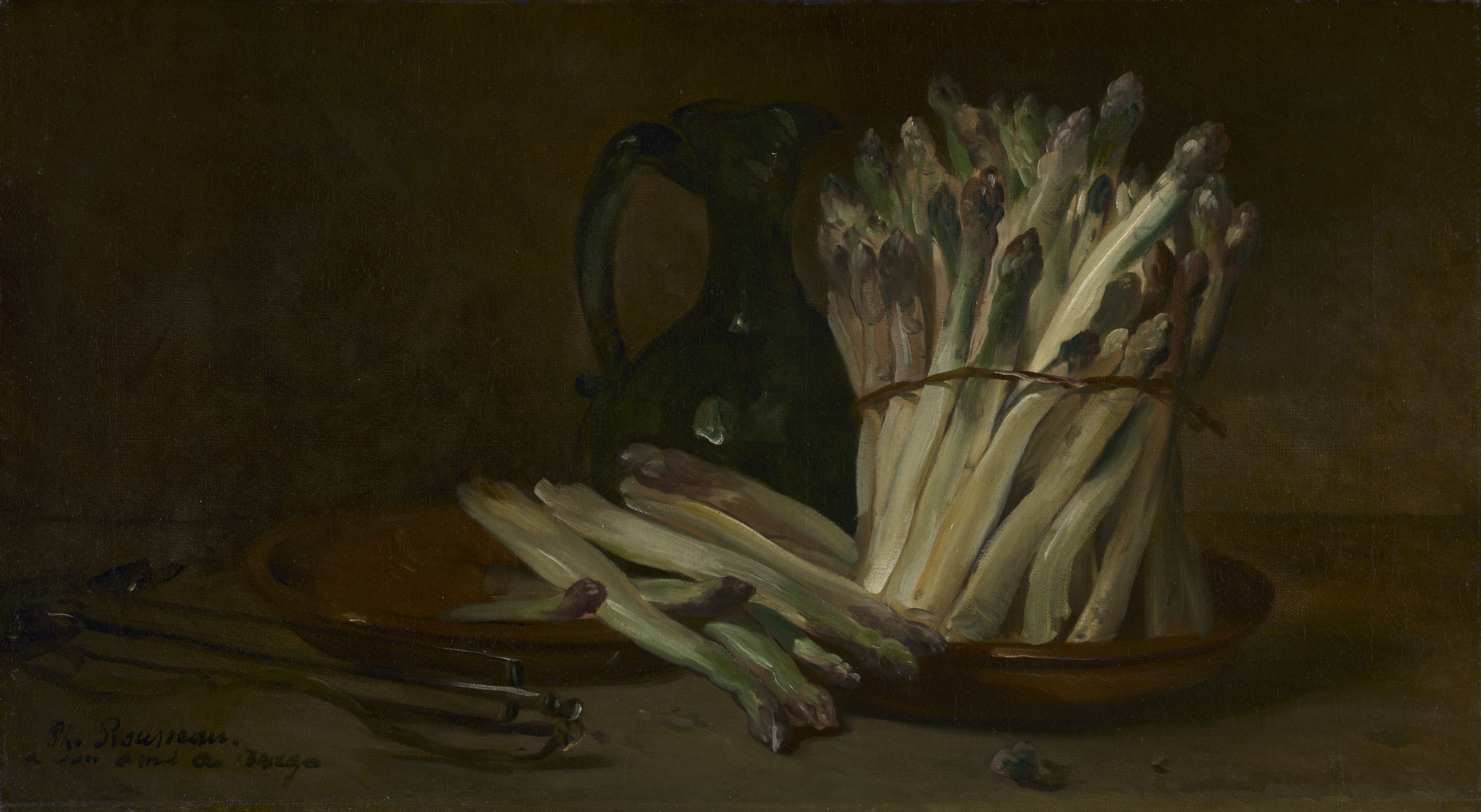The Cleveland Museum of Art
Collection Online as of April 25, 2024

Still Life with Asparagus
c. 1880
Location: not on view
Description
Rousseau was profoundly influenced by the atmospheric still lifes of Jean Siméon Chardin (1699-1779), whom the artist and other French painters like François Bonvin (1817-1877) rediscovered in the mid-1800s. A comparison with Chardin's work, also shown in this gallery, indicates that Rousseau similarly depicted foodstuffs on a simple kitchen table, concentrating on rich textures and restrained colors.- After 1880- ?Alfred Arago [1815-1892], Paris?Charles Guérin, Lyon1977(Sale, Hôtel Drouot, Paris, May 9-10, 1977 (no. 100), sold to Galerie Galerie Brame-Lorenceau)1977(Galerie Brame-Lorenceau, Paris, sold to Noah L. Butkin and Muriel S. Butkin)1977-1980Noah L. [1918-1980] and Muriel S. Butkin [1915-2008], Cleveland, OH, bequeathed to the Cleveland Museum of Art as a result of disclaimer by Muriel S. Butkin1980-The Cleveland Museum of Art, Cleveland, OHProvenance Footnotes1 Inscribed “à son ami A Arago,” this painting was given by Rousseau to his friend, Alfred Arago. Arago was a student of Delaroche and painted genre, history, and landscape paintings. In 1853, during the most successful period in Rousseau’s career, Arago became Inspecteur des Beaux-Arts, an important post in the fine arts administration. Thus, the painting may have been not only a token of friendship but also a demonstration of Rousseau’s appreciation for Arago’s service.2 Bernard Lorenceau of Galerie Brame-Lorenceau furnished CMA with the name Charles Guérin, whom Lorenceau identified as a professor in Lyon who had died by 1983.3 The names of the consignors to this sale are not disclosed in the catalogue, which identifies the listed works only as coming from the “collection de Madame X et divers amateurs.” There are no specific indications that Guérin consigned any paintings to this sale, so the source of Rousseau’s painting remains unknown.
- Weisberg, Gabriel P. The Realist Tradition: French Painting and Drawing, 1830-1900. Cleveland: Cleveland Museum of Art, 1980.d'Argencourt, Louise, Roger Diederen, and Alisa Luxenberg. European Paintings of the 19th Century. Cleveland: Cleveland Museum of Art, 1999.Bernard Lorenceau, letter to Linda Jackson, Feb. 8, 1983.Hôtel Drouot. Tableaux modernes. May 9-10, 1977.Sylvie Brame, email to Victoria Sears Goldman, Jan. 29, 2015, in CMA curatorial file.Sylvie Brame, email to Victoria Sears Goldman, Jan. 29, 2015, in CMA curatorial file.Estate of Noah L. Butkin, Bequests to Cleveland Museum of Art as a result of disclaimer by Murel S. Butkin. Estates, Gifts, and Funds, Series 1, Box 2:14. Cleveland Museum of Art Archives.Phillippe Brame, letter to Linda Jackson, Oct. 4, 1983, in CMA curatorial file.Estate of Noah L. Butkin, Bequests to Cleveland Museum of Art as a result of disclaimer by Murel S. Butkin. Estates, Gifts, and Funds, Series 1, Box 2:14. Cleveland Museum of Art Archives.Argencourt, Louise d', and Roger Diederen. Catalogue of Paintings. Pt. 4. European Paintings of the 19th Century. Cleveland: Cleveland Museum of Art, 1974. Mentioned and reproduced: P. 560-561, Vol. II, no. 197Koos, Marianne. "Manet and the Reception of Chardin in Nineteenth-Century French Painting." In Praised and Ridiculed: French Painting 1820-1880. Zürcher Kunstgesellschaft, ed., 44-55. Munich: Hirmer; Zürich: Kunsthaus Zürich, [2017]. Reproduced: P. 164, cat. 97; Mentioned: P. 50
- Praised and Ridiculed: French Painting 1820 - 1880. Kunsthaus Zürich, CH-8024 Zürich, Switzerland (organizer) (November 10, 2017-January 28, 2018).Philippe Rousseau. Van Gogh Museum (organizer) (September 10-November 14, 1993).Amsterdam, Van Gogh Museum. Nineteenth-Century Masters 1: Philippe Rousseau 1816-1887 (1993), 63, no. 23, fig. 62.Southampton, Parrish Art Museum; New York, National Academy of Design. In Support of Liberty: European Paintings at the 1883 Pedestal Fund Art Loan Exhibition (1986), no. 74 (repr.).Consuming Passions: The Art of Food and Drink. The Cleveland Museum of Art, Cleveland, OH (organizer) (July 26-October 9, 1983).CMA; Beck Center for the Cultural Arts, Lakewood, Ohio; Beachwood (Ohio) Museum; Toledo Museum of Art. Consuming Passions: The Art of Food and Drink (1983-84), 9-10, fig. 6, 47.Year in Review: 1980. The Cleveland Museum of Art (organizer) (June 24-July 19, 1981).The Realist Tradition: French Painting and Drawing 1830 - 1900. The Cleveland Museum of Art, Cleveland, OH (organizer) (November 12, 1980-January 18, 1981).CMA. Chardin and the Still-Life Tradition in France (1979), 34, 42, 75 (repr.), 76, 90, no. 26.CMA; Brooklyn Museum; Saint Louis Art Museum; Glasgow Art Gallery and Museum. The Realist Tradition: French Painting and Drawing 1830-1900 (1980-82). Text by Gabriel P. Weisberg. 150, no. 117 (repr.).
- {{cite web|title=Still Life with Asparagus|url=false|author=Philippe Rousseau|year=c. 1880|access-date=25 April 2024|publisher=Cleveland Museum of Art}}
Source URL:
https://www.clevelandart.org/art/1980.284